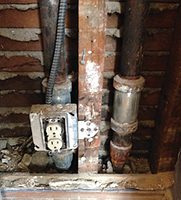Hydronics troubleshooting

We had a very mild fall here in the D.C. metro area. As such, we did not run into many service issues until the weather turned colder towards mid-December. A cold snap brought in a flurry of calls. One call was a system in Arlington, Virginia. It was a baseboard loop system in a 1950s rambler with a finished basement. We had been there a couple of times for an insufficient heat complaint. The heat was working, but it would not maintain 70 F at the thermostat. On one cold morning, with temperatures in the low teens, the thermostat was reading 58 F when my technician arrived at 7:30 a.m.
My technician found the boiler running, the circulator pump was running, and the copper fin tube baseboard was hot. A cursory check of all the components indicated everything was fine. As calls were stacking on that cold morning, I did not want to tie up one of my techs all morning chasing a ghost. I had him pack up and roll to the next call.
"It could be an intermittent problem. It could an insulation issue. It could be infiltration or bad windows," I thought.
I decided I would stop by this job and take a look for myself.
I always ask myself, “what changed?”
This house was over 60 years old. It could not have always had this issue. At some time, it heated properly. Then it didn’t. The key was to find out what changed to create this situation where the boiler system could not maintain temperature on cold days.
The first thing I do is interview the owner(s). I want to hear the issues and concerns directly from them. Everyone is different. What is comfortable for me may not be acceptable for someone else. In this case, two key bits of information jumped out. One, they were new owners. They had just purchased this home, and this was their first winter in the home. The second bit of information was that they like to keep it 72 F, a little warm for my taste but certainly achievable at the current ambient temperature.
After interviewing the owners, I like to survey the entire system. This means every component in the system, not just the boiler room. I like to do this alone, as I cannot concentrate when I am chatting with the client or answering questions. I politely explain to the client that I need peace and quiet to think things through. They are welcome to follow me and watch but I find that I miss clues when I am talking rather than concentrating on solving the problem.
The first thing I did was set the thermostat up and observe the operation of the system. The boiler was a fairly new Burnham Series 2, approximately seven years old (See Photo No. 1). The relay clicked, the vent damper opened, the circulator pump kicked on, the pilot lit, then the main burners lit.
The boiler and external controls were working properly.
As the boiler came up to temperature, I sketched out the near boiler piping. Often, there is a maze of piping, and I find sketching it out makes it easier to spot piping problems. In this case, it was not textbook-perfect. The circulator was pumping towards the expansion tank. The primary supply dropped from 1 inch copper to ¾ inch copper, and then ran to a bull-headed tee (See Photo No. 2). While the piping was not ideal, it was not enough of an issue to cause the described deficiencies. It was not a “new” problem, as it had been that way since the boiler was installed.
I waited for the boiler to come up to setpoint and checked the returns. The supply split into two baseboard loops. After about 15 minutes of runtime, both returns were hot. This was not a flow or air issue. I did not do a load calculation, but the boiler size passed the eye test. It certainly had the capacity to heat the connected baseboard. If anything, it may have been over-sized. Within 15 minutes of runtime, the boiler was cycling on limit. This did not appear to be an undersized boiler.
I then surveyed the visible piping and baseboard throughout the house. A few things caught my eye. A great room addition was added to the back of the house. Most of the outside walls were windows which ran to the floor and sliding glass doors. Only one wall had a run of baseboard. The damper was almost all the way closed and a sideboard was pushed up tight to the wall. I explained to the client that baseboard heated by convection, not radiation. It needed room to “breathe.” Once I opened the baseboard damper all of the way and pulled the sideboard out from the wall a few inches, warm air started wafting up from the baseboard. This was certainly not the primary issue but every little bit helps.
I noticed a stairwell going up to a finished attic. There was no door, just an open archway leading to the attic. The finished attic contained an office and a bedroom and was heated by electric baseboard. Both baseboards were not operational, and an electrician was scheduled to come out and repair them. My first inclination was to skip this area as it was not heated by the hydronic system. It was a good thing I did not. As I walked up the stairs, it was noticeably cooler. As the electric baseboards were not working, warm air was drafting up the open stairwell into the attic. The cold attic was pulling heat from the main floor. Again, this was not the problem, but it was a contributing factor.
Next, I went to the thermostat, which was a Honeywell programmable model. I went into the program and noticed that there was a 10 F setback twice a day. This may be achievable in mild weather, but it was not going to make up that large setback when the ambient temperature was in the teens or single digits. I recommended a more modest 3 – 5 F setback and see how that worked.
I explained to my client that the large setback allowed the boiler and the mass of the house to cool down. It behaved like a giant flywheel. On a cold morning, the system could not make up the setback fast enough to keep them comfortable. This was a contributing factor but again, not the primary cause of the temperature issue.
The next thing I did was survey all of the baseboard elements to make sure they were hot. I walked the entire house, and all of the fin tube element was scorching hot. But, one detail caught my eye. In several rooms, the finish floor ran tight to the bottom of the baseboard covers. Now, I was on to something. As mentioned earlier, copper fin tube baseboard requires airflow across the element to heat by convection. In this case, tile and carpet blocked this airflow (See Photo No. 3 and 4). A little heat would flow from the elements but not enough to maintain temperature in extremely cold weather. And, certainly not enough to make up a deep setback.
I found out that the home had been renovated a few years earlier. When the new floors went in, they ran them too high, right up to the bottom of the baseboard. This was the primary contributing cause of the system underperforming. The other problems noted contributed to the problem but the lack of convective airflow through the baseboard was by far the biggest factor.
When troubleshooting, you must look at the entire system ask, “what changed?” Do not stop at the first problem or issue you discover. It may not be the only problem. Look at everything before drawing conclusions and recommending solutions to your client.
Dan Foley is president and owner of Foley Mechanical, Inc. based in Lorton, Virginia. FMI specializes in radiant, hydronic and steam systems as well as mechanical systems for large custom homes. He can be reached at 703-339-8030, dfoley50@verizon.net, or www.foleymechanical.com.





